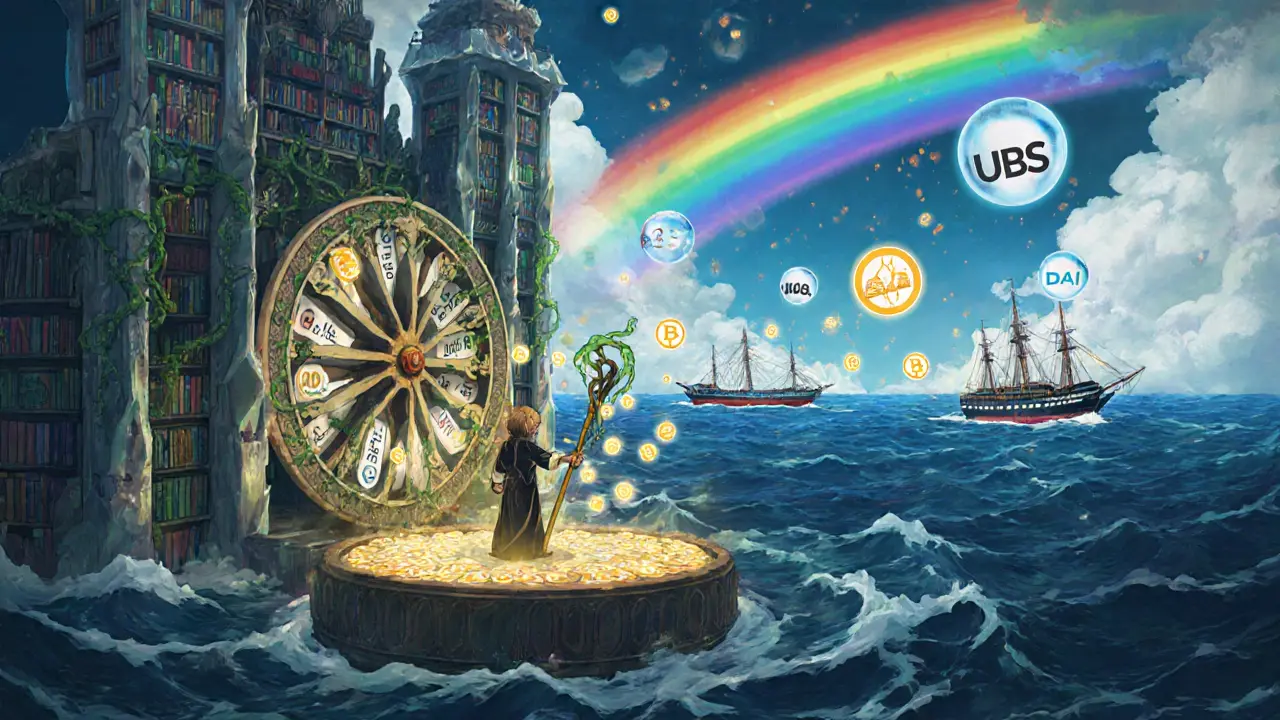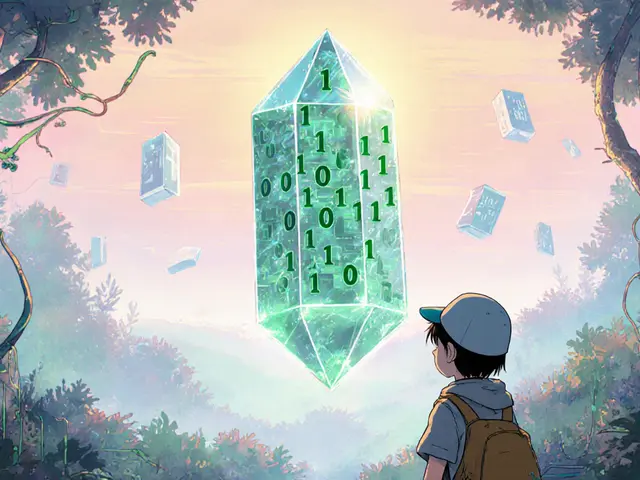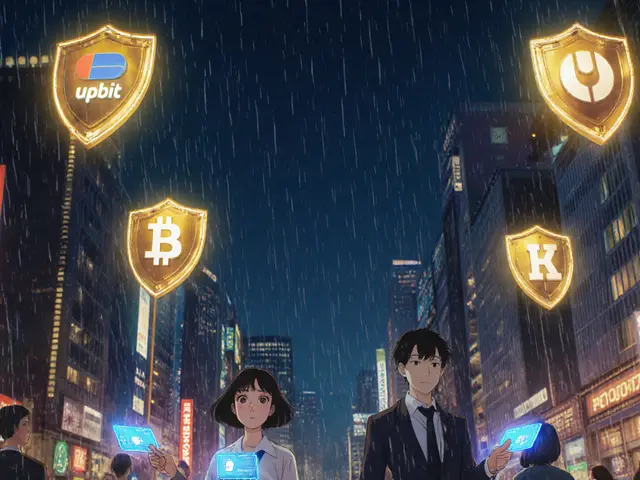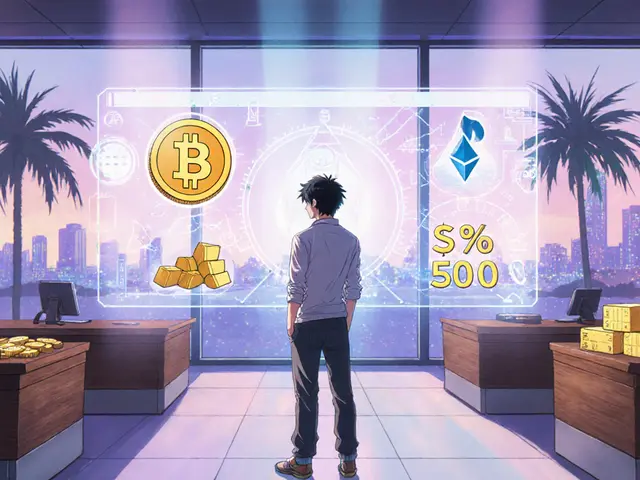Chainlink Oracle Cost Estimator
Estimate the cost in LINK tokens for requesting real-world data through Chainlink's decentralized oracle network. Costs vary based on data type, frequency, and request duration.
The price of data is market-driven: high-frequency data costs more than daily data. Costs are paid in LINK tokens to node operators.
Estimated Cost
0.00 LINK
Estimated LINK token cost for your data request
Cost Breakdown
Chainlink costs vary based on market demand. High-frequency requests (like stock prices) cost more than daily data. The network uses economic incentives to ensure data reliability and security.
Chainlink isn’t a currency you spend at the store or a coin you mine like Bitcoin. It’s the invisible plumbing behind thousands of smart contracts that need real-world data to work - like stock prices, weather reports, or the winner of a soccer match. Without Chainlink, most DeFi apps would be stuck in a bubble, unable to react to anything happening outside their own blockchain.
Why Blockchains Need Outside Data
Smart contracts are automated agreements that run on blockchains. They’re great at doing things like paying out insurance claims when a flight is delayed - but only if they know the flight was actually delayed. Blockchains can’t just reach out to a website and ask for that info. They’re designed to be isolated, secure, and tamper-proof. That’s also their biggest limitation.Chainlink solves this. It’s a decentralized network of independent computers - called nodes - that fetch real-world data and feed it securely into smart contracts. Think of it like a trusted courier who delivers verified information from the outside world into the blockchain’s locked room. The data doesn’t come from one source. It comes from dozens, sometimes hundreds, of different nodes. If one node gives bad data, the others override it.
What Is the LINK Token?
LINK is the native cryptocurrency of the Chainlink network. It’s an ERC-20 token built on Ethereum, which means it works seamlessly with most wallets and DeFi platforms. Unlike Bitcoin or Ethereum, LINK isn’t meant to be a store of value or a medium of exchange. It’s a utility token - a payment system for services.Node operators who provide data get paid in LINK. If you’re running a node that delivers live price feeds for Bitcoin or Ethereum, you earn LINK for your work. Users who need data pay in LINK. The price of data isn’t fixed - it’s set by the market. Need a high-frequency stock price update? That’ll cost more than a daily weather report.
LINK also powers staking. Node operators must lock up (or "stake") LINK tokens as collateral. If they provide false or unreliable data, they lose part of their stake. If they’re accurate and reliable, they earn more LINK in rewards. This economic design makes the network self-policing - bad actors lose money, good actors get paid.
How Chainlink Works: The Three-Step Process
Getting data from the real world into a smart contract isn’t simple. Chainlink breaks it down into three clear steps:
- Oracle Selection: A developer creates a request - like "What’s the current price of ETH in USD?" - and posts it on the Chainlink network. The system matches the request with the best-suited node operators based on their track record, speed, and cost.
- Data Reporting: Selected nodes fetch the requested data from trusted external sources - like financial APIs, sports databases, or weather services. Each node independently retrieves the same info.
- Result Aggregation: All the responses are sent to an Aggregation Contract. It compares the data points, drops outliers, and calculates a final, weighted result. If 9 out of 10 nodes say ETH is $3,200, and one says $1,000, the outlier gets ignored. The final number gets sent back to the smart contract.
This multi-node verification is what makes Chainlink so secure. No single point of failure. No central server to hack. No one company controlling the data.

Real-World Use Cases
Chainlink isn’t just theoretical. It’s already powering major financial and crypto systems:
- DeFi Lending: Platforms like Aave and Compound use Chainlink price feeds to know when to liquidate undercollateralized loans. A 1% error could cost users millions.
- Stablecoins: Projects like DAI rely on Chainlink to verify asset values so their coins stay pegged to the dollar.
- Insurance: Smart contracts can automatically pay out if a flight is delayed - Chainlink pulls flight status data from airline APIs.
- GameFi: Crypto games use Chainlink’s Verifiable Random Function (VRF) to generate provably fair outcomes - like who wins a loot box or a dice roll.
- Tokenized Assets: Institutions like UBS and Mastercard use Chainlink to verify ownership and value of real-world assets on-chain, like bonds or real estate.
Even global financial networks like SWIFT and Euroclear use Chainlink to connect traditional banking systems with blockchain-based ledgers. This isn’t just for crypto nerds - it’s infrastructure for the future of finance.
Advanced Features That Set Chainlink Apart
Chainlink doesn’t just deliver price data. It offers specialized tools:
- Chainlink VRF: Generates cryptographically secure, tamper-proof random numbers. Used in NFT drops and online casinos to prove fairness.
- Chainlink Proof of Reserve: Lets users verify that a crypto exchange or lending platform actually holds the assets it claims to. No more FTX-style surprises.
- Hybrid Smart Contracts: Combine on-chain logic with off-chain computation. Need to calculate a complex financial model? Chainlink can run it off-chain and feed the result back - saving gas fees.
- Chainlink CCIP: Enables cross-chain communication. A smart contract on Ethereum can now safely trigger actions on Solana, Polygon, or any other blockchain.
These aren’t gimmicks. They’re essential tools for building real, scalable blockchain applications.

Who Runs Chainlink?
Chainlink is decentralized, but it wasn’t built by a faceless group. It was launched in 2019 by Sergey Nazarov, Steve Ellis, and Ari Juels - all experienced in cryptography and distributed systems. The project is managed by Chainlink Labs, a U.S.-based company, but the network itself runs on over 90 independent node operators.
These operators include big names like Coinbase, Kraken, Binance, and even Vodafone. That’s not just marketing - it’s proof that major players trust Chainlink’s reliability. These companies aren’t just users - they’re validators. They run nodes because they need accurate data for their own services.
Supply and Economics of LINK
There’s a hard cap of 1 billion LINK tokens. As of September 2025, about 700 million are in circulation. The rest are reserved for future incentives, node rewards, and the Chainlink Reserve - a fund that takes a portion of all revenue generated by the network and converts it into LINK, locking it away to reduce selling pressure.
Unlike Bitcoin’s fixed mining rewards, Chainlink’s tokenomics are demand-driven. More adoption = more data requests = more LINK paid out to node operators. That creates a natural upward pressure on demand. The network doesn’t rely on inflation to reward participants - it relies on real economic activity.
Why Chainlink Matters
Blockchain technology can’t move beyond niche use cases unless it can interact with the real world. Chainlink is the bridge. It’s the reason DeFi works. It’s the reason insurance can be automated. It’s the reason you can trust a crypto game’s random outcomes.
Without Chainlink, smart contracts are like robots with no eyes or ears. Chainlink gives them senses. And as more industries - from insurance to supply chains to government services - start moving onto blockchains, the demand for reliable, secure data feeds will only grow.
Chainlink isn’t the flashiest crypto. It doesn’t have memes or celebrity endorsements. But it’s one of the few projects that’s actually solving a foundational problem - and it’s already being used by the biggest names in finance and tech.
Is LINK a good investment?
LINK isn’t a typical investment. It’s a utility token. Its value comes from usage - the more smart contracts need data, the more LINK gets paid out. If Chainlink continues to be the dominant oracle network, demand for LINK will likely rise. But if another network outperforms it, LINK’s value could stagnate. Don’t buy LINK hoping it’ll moon - buy it because you believe in the infrastructure it powers.
Can I mine LINK?
No. LINK isn’t mined. It was pre-mined at launch with a fixed supply. New LINK enters circulation only through rewards paid to node operators for providing data services. You can’t mine it like Bitcoin - but you can run a node and earn LINK by providing reliable data.
How is Chainlink different from other oracles?
Most early oracles were centralized - one company, one data source. That created a single point of failure. Chainlink is decentralized, using dozens of independent nodes with economic incentives to be honest. It also aggregates data from multiple sources and uses staking to punish bad actors. This makes it far more secure and reliable than single-source oracles.
Does Chainlink run on its own blockchain?
No. Chainlink operates as a layer-2 service on top of existing blockchains, primarily Ethereum. It doesn’t have its own chain. Instead, it connects to any blockchain that supports smart contracts - including Bitcoin (via sidechains), Solana, Polygon, and more. This makes it universally compatible.
Can I use Chainlink without knowing how to code?
Yes - if you’re using a DeFi app like Aave or a game that uses Chainlink’s random number generator, you’re already using it. You don’t need to understand the backend. But if you want to build your own smart contract that uses Chainlink data, you’ll need to learn how to integrate its API. There are developer tools and documentation available, but it’s not for beginners.






Michael Faggard
November 13, 2025 AT 20:27 PMChainlink is the unsung hero of DeFi. Without it, smart contracts are just fancy scripts with no access to reality. The way it aggregates data from dozens of nodes is genius-no single point of failure, no corporate middleman pulling strings. This isn’t speculation; it’s infrastructure. And LINK isn’t a coin-it’s the fuel. You don’t buy gasoline hoping it’ll appreciate, you buy it because your car needs it to move. Same deal.
Ainsley Ross
November 14, 2025 AT 23:29 PMI appreciate how thoughtfully this was explained. As someone who works in financial compliance, I’ve watched centralized oracles fail spectacularly-FTX, Celsius, you name it. Chainlink’s staking mechanism and multi-source validation are the exact kind of systemic safeguards we need. It’s not flashy, but it’s *safe*. And in finance, safety is the ultimate luxury.
Debraj Dutta
November 16, 2025 AT 16:10 PMVery clear breakdown. In India, we’re seeing more DeFi adoption, but most people still think crypto is just gambling. Posts like this help explain why Chainlink matters beyond price charts. The VRF for games and Proof of Reserve for exchanges? These aren’t niche features-they’re foundational.
tom west
November 17, 2025 AT 15:03 PMLet’s be real-Chainlink is overhyped. Yes, it’s decentralized, but how many of those 90+ node operators are actually independent? Binance, Coinbase, Kraken? They’re all part of the same oligopoly. This isn’t decentralization-it’s corporate capture with a blockchain veneer. And LINK? A utility token? Please. It’s a pump-and-dump vehicle disguised as infrastructure. The real value is in the enterprise contracts, not the token. Don’t be fooled.
dhirendra pratap singh
November 18, 2025 AT 20:03 PMOMG I JUST REALIZED-CHAINLINK IS LIKE THE GOD OF BLOCKCHAIN!!! 🙏🔥 Without it, smart contracts are blind, deaf, and DUMB!!! I mean, imagine a robot trying to pay your rent but it has NO IDEA what the stock market is doing!!! 😱 This isn’t crypto, this is THE FUTURE!!! I cried when I learned about VRF-my NFTs are now FAIR!!! 💔✨
Ashley Mona
November 19, 2025 AT 09:57 AMSo many people miss the point-LINK’s value isn’t about speculation. It’s about *incentives*. Node operators risk their own capital. That’s the magic. It’s not ‘trust us’-it’s ‘we have skin in the game.’ And the way it scales across chains? CCIP is going to be the reason we stop seeing blockchain as a siloed mess. This is the quiet revolution.
Edward Phuakwatana
November 20, 2025 AT 06:19 AMThink of Chainlink as the nervous system of Web3. Every time a DeFi protocol liquidates a loan, every time a lottery picks a winner, every time your insurance pays out after a storm-it’s Chainlink’s synapses firing. It’s not sexy like a new NFT collection, but without it, the whole body shuts down. The real innovation? It doesn’t just connect data-it *verifies* it. That’s the difference between a phone line and a secure encrypted channel. And LINK? It’s the neurotransmitter. No signal, no action. Simple as that.
Suhail Kashmiri
November 22, 2025 AT 02:44 AMlol who even uses this stuff? My uncle bought LINK because he saw it on TikTok. He thinks it’s gonna make him rich. Meanwhile, real people are building actual stuff with it. You don’t need to hold LINK to use it. Just like you don’t need to own a power plant to use electricity. Chill out.